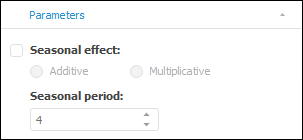 To apply the method
To apply the methodTool interfaces in the web application and in the desktop application are identical, and differences in functionality are given in appropiate commments.
The method enables the user to remove the seasonal component from a time series and create a theoretical time series based on a change pattern expressed in mathematical terms. The following trend models are available in the time series database:
Autotrend.
NOTE. On changing the data of the source series, the Autotrend calculated series automatically takes the optimal trend and it is recalculated.
Geometric trend.
Linear trend.
Logarithmic parabolic trend.
Inverse trend.
Parabolic trend.
Exponential trend.
Trend methods are included in the Forecasting group.
After the method is applied, in the workbook, based on each selected series a calculated series with a name of the <Method_Name>(<Series_Name>) type is created, containing the calculation results. For example:

To set up calculation parameters, use the Parameters side panel tab.

Specify method parameters on the tab:
Seasonal Effect. To consider it on calculating seasonal effect, select the Seasonal Effect checkbox. Select the method to exclude the seasonal component from the source series:
Additive. Default. The series is considered as a sum of systematic and irregular components.
Multiplicative. The series is considered as a product of systematic and irregular components.
If there is no seasonality, equation coefficients are estimated based on the source series using the least-squares method.
If the series contains a seasonal component, first the calculations, connected to excluding this periodically repeating component from the original series, are performed. After the seasonal component has been calculated and excluded from the source series, equation coefficients are estimated. Linear method of least squares is used for estimation.
Seasonal Period. Determine the length of the seasonal period by means of the value editor or the keyboard. The parameter is used if any seasonal effect is specified.
See also:
Working with Calculated Series | Trend with Functional Dependency Estimation | Modeling Container Trend with Functional Dependency Estimation | IModelling.Extrapolate